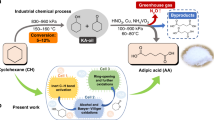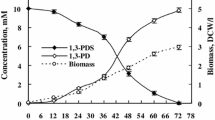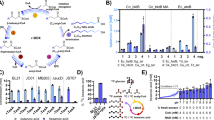Abstract
Enantiopure epoxides are valuable intermediates in the synthesis of optically pure biologically active fine chemicals (e.g., pharmaceuticals) that are often difficult to produce by chemical approaches. An attractive alternative is biological synthesis by microorganisms expressing stereoselective enzymes. In this study, we investigated the ability of ethene-grown Nocardioides sp. strain JS614 to produce highly enantio-enriched epoxyalkanes via stereoselective monooxygenase-mediated alkene epoxidation. Ethene-grown JS614 cells transformed propene, 1-butene, and trans-2-butene to their corresponding epoxyalkanes at rates ranging from 27.1 to 44.0 nmol/min mg protein. Chiral gas chromatography analysis revealed that R-1,2-epoxypropane, R-1,2-epoxybutane, and trans-2R,3R-epoxybutane were produced in enantiomeric excess (e.e.) of 98%, 74%, and 82%, respectively. Ethene-grown JS614 cells also preferentially transformed trans-2S,3S-epoxybutane from a racemic mixture, but could not resolve racemic 1,2-epoxypropane. Glucose facilitated increased epoxyalkane production by ethene-grown JS614 cells. However, after 22 h of propene biotransformation with 20 mM glucose, 84% of ethene-grown JS614 cells lost membrane integrity and the remaining live cells were not viable. Propene biotransformation by JS614 was extended beyond 22 h and 54% more epoxypropane was produced when cells were resuspended in fresh buffer + glucose at 8-h intervals. We conclude that JS614 is a promising new biocatalyst for applications that involve enantiopure epoxide production.




Similar content being viewed by others
References
Archelas A, Furstoss R (1997) Synthesis of enantiopure epoxides through biocatalytic approaches. Annu Rev Microbiol 51:491–525
Caron GN-V, Badley S (1998) Assessment of bacterial viability status by flow cytometry and single cell sorting. J Appl Microbiol 84:988–998
Chion CK, Askew SE, Leak DJ (2005) Cloning, expression, and site-directed mutagenesis of the propene monooxygenase genes from Mycobacterium sp. strain M156. Appl Environ Microbiol 71:1909–1914
Coleman NV, Mattes TE, Gossett JM, Spain JC (2002) Phylogenetic and kinetic diversity of aerobic vinyl chloride-assimilating bacteria from contaminated sites. Appl Environ Microbiol 68:6162–6171
Crossley R (1992) The relevance of chirality to the study of biological activity. Tetrahedron 48:8155–8178
de Haan A, Smith MR, Voorhorst WGB, de Bont JA (1993) Co-factor regeneration in the production of 1, 2-epoxypropane by strain E3: the role of storage material. J Gen Microbiol 139:3017–3022
Habets-Crützen AQH, Bont JAM (1985) Inactivation of alkene oxidation by epoxides in alkene-and alkane-grown bacteria. Appl Microbiol Biotechnol 22:428–433
Habets-Crützen AQH, de Bont JAM (1987) Effect of various co-substrates on 1, 2-epoxypropane formation from propene by ethene-utilising Mycobacteria. Appl Microbiol Biotechnol 26:434–438
Habets-Crützen AQH, Brink LES, Ginkel CG, Bont JAM, Tramper J (1984) Production of epoxides from gaseous alkenes by resting-cell suspensions and immobilized cells of alkene-utilizing bacteria. Appl Microbiol Biotechnol 20:245–250
Habets-Crutzen AQH et al (1985) Stereospecific formation of 1, 2-epoxypropane, 1, 2-epoxybutane and 1-chloro-2, 3-epoxypropane by alkene-utilizing bacteria. Enzyme Microb Technol 7:17
Halsey K, Sayavedra-Soto L, Bottomley P, Arp D (2005) Trichloroethylene degradation by butane-oxidizing bacteria causes a spectrum of toxic effects. Appl Microbiol Biotechnol 68:794
Kline SA, McCoy EC, Rosenkranz HS, Van Duuren BL (1982) Mutagenicity of chloroalkene epoxides in bacterial systems. Mutat Res 101:115–125
Mahmoudian M, Michael A (1992a) Biocatalysts for production of chiral epoxides. Appl Microbiol Biotechnol 37:23–27
Mahmoudian M, Michael A (1992b) Production of chiral epoxides by an ethene-utilising Micrococcus sp. J Ind Microbiol Biotechnol 11:29
Matsumura H, Miyachi S (1980) Cycling assay for nicotinamide adenine dinucleotides. Methods Enzymol 69:465–470
Mattes TE, Coleman NV, Gossett JM, Spain JC (2005) Physiological and molecular genetic analyses of vinyl chloride and ethene biodegradation in Nocardioides sp. strain JS614. Arch Microbiol 183:95–106
Mattes TE, Coleman NV, Chuang AS, Rogers AJ, Spain JC, Gossett JM (2007) Mechanism controlling the extended lag period associated with vinyl chloride starvation in Nocardioides sp. strain JS614. Arch Microbiol 187:217–226
McClay K, Fox BG, Steffan RJ (2000) Toluene monooxygenase-catalyzed epoxidation of alkenes. Appl Environ Microbiol 66:1877–1882
Meyers PR, Bourn WR, Steyn LM, van Helden PD, Beyers AD, Brown GD (1998) Novel method for rapid measurement of growth of mycobacteria in detergent-free media. J Clin Microbiol 36:2752–2754
Oldenhuis R, Oedzes JY, van der Waarde JJ, Janssen DB (1991) Kinetics of chlorinated hydrocarbon degradation by Methylosinus trichosporium OB3b and toxicity of trichloroethylene. Appl Environ Microbiol 57:7–14
Parales RE, Bruce NC, Schmid A, Wackett LP (2002) Biodegradation, biotransformation, and biocatalysis (B3). Appl Environ Microbiol 68:4699–4709
Rannug U, Gothe R, Wachtmeister CA (1976) The mutagenicity of chloroethylene oxide, chloroacetaldehyde, 2-chloroethanol and chloroacetic acid, conceivable metabolites of vinyl chloride. Chem Biol Interact 12:251–263
Roszak DB, Colwell RR (1987) Survival strategies of bacteria in the natural environment. Microbiol Rev 51:365–379
Sander R (1999) Compilation of Henry's law constants for inorganic and organic species of potential importance in environmental chemistry (Version 3). In: http://www.henrys-law.org
van Beilen JB, Duetz WA, Schmid A, Witholt B (2003) Practical issues in the application of oxygenases. Trends Biotechnol 21:170–177
van Ginkel CG, Welten HGJ, de Bont JAM (1987) Oxidation of gaseous and volatile hydrocarbons by selected alkene-utilizing bacteria. Appl Environ Microbiol 53:2903–2907
Weijers CAGM, Haan A, Bont JAM (1988a) Chiral resolution of 2, 3-epoxyalkanes by Xanthobacter Py2. Appl Microbiol Biotechnol 27:337
Weijers CAGM, van Ginkel CG, de Bont JAM (1988b) Enantiomeric composition of lower epoxyalkanes produced by methane-, alkane-, and alkene-utilizing bacteria. Enzyme Microb Technol 10:214
Yeager CM, Bottomley PJ, Arp DJ (2001) Cytotoxicity associated with trichloroethylene oxidation in Burkholderia cepacia G4. Appl Environ Microbiol 67:2107–2115
Acknowledgments
This work was supported by the Engineering Research Centers Program of the National Science Foundation under NSF Award Number EEC-0310689 and by the University of Iowa start-up funds for T.E.M. We thank Scott Ensign for generously providing Xanthobacter Py2 and for providing Py2 culturing advice. We also thank Horacio Olivo for helpful discussions. Finally, we thank Justin Fishbaugh for technical expertise and assistance on flow cytometry analyses.
Author information
Authors and Affiliations
Corresponding author
Rights and permissions
About this article
Cite this article
Owens, C.R., Karceski, J.K. & Mattes, T.E. Gaseous alkene biotransformation and enantioselective epoxyalkane formation by Nocardioides sp. strain JS614. Appl Microbiol Biotechnol 84, 685–692 (2009). https://doi.org/10.1007/s00253-009-2019-3
Received:
Revised:
Accepted:
Published:
Issue Date:
DOI: https://doi.org/10.1007/s00253-009-2019-3




